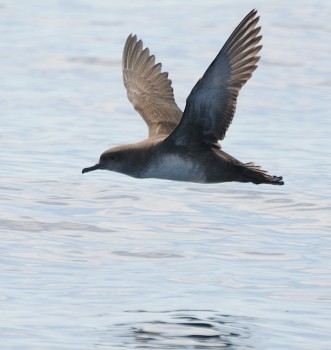Rhiannon Meier (National Oceanography Centre, Southampton, UK,) and colleagues have published in the open-access journal Diversity and Distributions on the foraging behaviour of the Critically Endangered and ACAP-listed Balearic Shearwater Puffinus mauretanicus.
The paper’s abstract follows:
“Aim. The movement patterns of marine top predators are likely to reflect responses to prey distributions, which themselves can be influenced by factors such as climate and fisheries. The critically endangered Balearic shearwater Puffinus mauretanicus has shown a recent northwards shift in non-breeding distribution, tentatively linked to changing forage fish distribution and/or fisheries activity. Here, we provide the first information on the foraging ecology of this species during the non-breeding period.
Location. Breeding grounds in Mallorca, Spain, and non-breeding areas in the north-east Atlantic and western Mediterranean.
Methods. Birdborne geolocation was used to identify non-breeding grounds. Information on feather moult (from digital images) and stable isotopes (of both primary wing feathers and potential prey items) was combined to infer foraging behaviour during the non-breeding season.
Results. Almost all breeding shearwaters (n = 32) migrated to non-breeding areas in the Atlantic from southern Iberia to the French Atlantic coast, where the majority of primary feather moult took place. Birds foraging off western Iberia yielded feather isotope ratios consistent with a diet composed largely of pelagic fishes, while the isotopic composition of birds foraging in the Bay of Biscay suggested an additional contribution of benthic prey, most likely from demersal fishery discards.
Main conclusions. Combined application of geolocators and stable isotopes indicates spatial variation in dietary behaviour and interactions with fisheries. Our results imply that both pelagic fish and fisheries discards are important components of diet during the non-breeding period, which may have implications for the at-sea distribution of this migratory species. These findings will contribute to bycatch mitigation in non-breeding areas and provide baseline data that should inform future assessment of seabird responses to changing fishery practices and prey distributions.”

Balearic Shearwater at sea
With thanks to Miguel McMinn for information.
Reference:
Meier, R.E., Votier, S.C., Wynn, R.B., Guilford, T, McMinn Grivé, M., Rodríguez, A., Newton, J., Maurice, L., Chouvelon, T., Dessier, SA. & Trueman, C.N. 2016. Tracking, feather moult and stable isotopes reveal foraging behaviour of a critically endangered seabird during the non-breeding season. Diversity and Distributions 1-16. DOI: 10.1111/ddi.12509.
John Cooper, ACAP Information Officer, 29 November 2016

 English
English  Français
Français  Español
Español